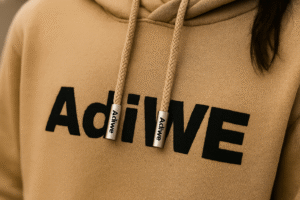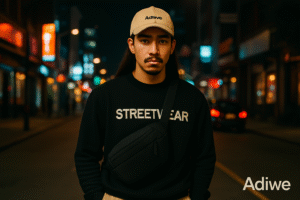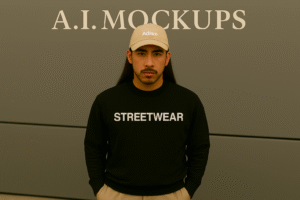Are you dreaming of launching your own streetwear line but feel lost about the costs involved? Hidden expenses can quickly derail your budget, putting your brand at risk before it even starts. Understanding the key cost factors upfront is crucial for planning and success.
Creating custom streetwear can cost anywhere from $10-$20 per piece for simple items in bulk, to $50-$150+ for complex designs like hoodies or jackets with premium materials and intricate details, especially in smaller quantities. Key factors include design complexity, fabric quality, order volume, and customization specifics.
Knowing a general price range isn't quite enough to build a solid financial plan for your brand. Many different elements contribute to the final price tag of your custom apparel. As a B2B factory owner at Adiwe, working with many startup and established brands like Fifty Fifty from the UK, I've seen firsthand how these factors add up. It's important to break them down to truly understand where your money goes, so let's dive into the details.
How Do I Start My Own Streetwear Brand?
Feeling the pull to launch your own streetwear brand but overwhelmed by where to begin? Without a clear roadmap, your unique vision might just stay a dream, or worse, fizzle out fast. A structured approach, from initial concept to final production, makes this exciting journey much more achievable.
To start your own streetwear brand, begin with a unique brand concept and identify your target audience. Develop distinct designs, find a reliable manufacturing partner like us at Adiwe, create and approve samples, plan your marketing strategy, and carefully manage your finances.
!
Starting your own streetwear brand is a thrilling venture, but it involves more than just cool designs. I always tell aspiring brand owners that a solid foundation is key.
-
Defining Your Brand Identity and Niche
First, really think about what your brand stands for. Who are you trying to reach? What makes your streetwear unique? Is it the aesthetic, the message, the quality, or a specific subculture you're tapping into? For example, Fifty Fifty knew they wanted to target young people with a confident style, focusing on design and quality.
-
Designing Your Collection
Once your brand identity is clear, you can start designing your first collection. This means creating detailed sketches, mock-ups, and importantly, "tech packs." Tech packs are like blueprints for clothing; they include all the specifications like measurements, materials, colors, print details, and construction notes. The more detailed your tech pack, the smoother the sampling and production process will be with your manufacturer.
-
Finding the Right Production Partner
This is where a factory like mine, Adiwe, comes in. You need a manufacturer who understands your vision, can produce the quality you need, and offers services like customizable fabrics and craftsmanship. Look for experience, good communication, and transparency.
-
Sampling, Production, and Launch
Before mass production, always get samples made. This is your chance to check the fit, fabric, print quality, and every detail. Once you approve the sample, you can move to bulk production. While your manufacturer handles this, you should be working on your marketing and sales strategy to launch your brand successfully.
| Phase | Key Action | Why It's Important for Cost & Success |
|---|---|---|
| 1. Concept | Define brand, target audience, USP | Guides all design and manufacturing decisions |
| 2. Design | Create detailed tech packs, mock-ups | Ensures clarity, reduces errors & sample costs |
| 3. Sourcing | Choose fabrics, trims, reliable manufacturer | Impacts quality, cost, and production time |
| 4. Sampling | Test fit, quality, design execution | Prevents costly mistakes in bulk production |
| 5. Production | Oversee quality, manage timelines | Delivers your final product to specification |
| 6. Marketing | Build brand presence, plan sales channels | Drives sales and brand growth |
Starting a brand is a big undertaking, but breaking it down into these steps makes it manageable. At Adiwe, we guide our clients through the sourcing, sampling, and production phases, ensuring their vision comes to life accurately.
How Much Does Custom Branding Cost?
Are you worried that the cost of essential branding elements like labels, tags, and packaging will inflate your budget? Using cheap or generic branding can unfortunately make even top-quality apparel seem amateur, undermining your brand's value and the hard work you've put into the designs. Investing wisely in custom branding, however, significantly enhances perceived value and reinforces your unique identity.
Custom branding elements like woven labels, hang tags, and custom packaging can range from $0.10 to $5.00+ per garment. The cost depends heavily on the materials used, design complexity, order quantity, and the specific type of branding chosen.
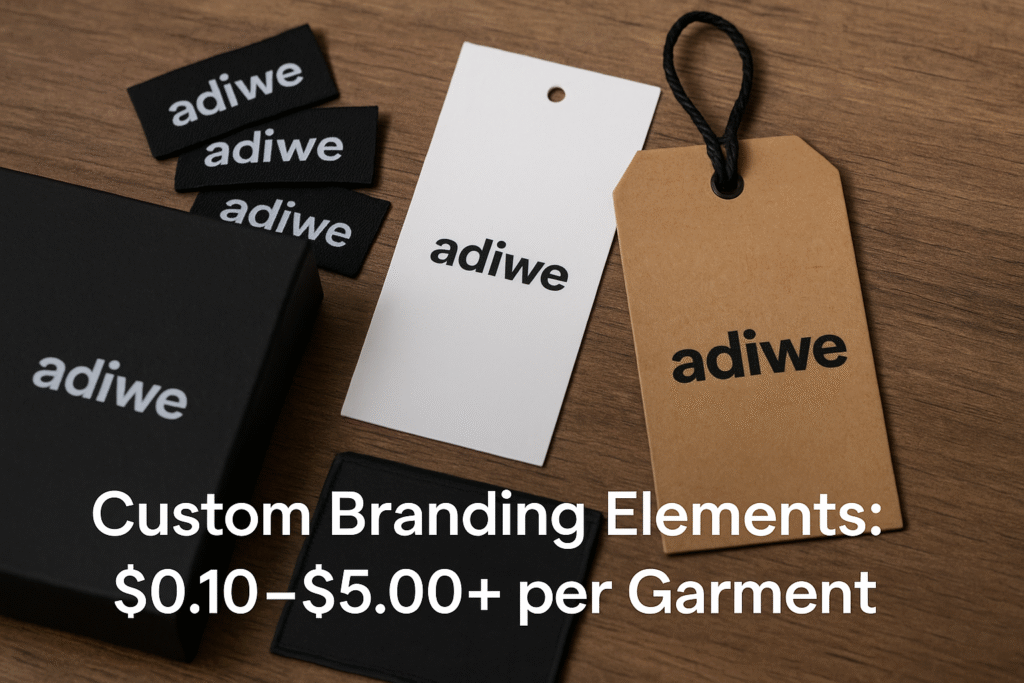
When my clients, including brands like Fifty Fifty who focus on design and quality, ask about branding costs, I always emphasize that these details are a crucial investment, not just an expense. They are the silent communicators of your brand's quality and personality.
-
Woven Labels vs. Printed Labels
Woven labels, typically found inside the neck or on a hem, offer a premium feel. The cost varies based on size, the number of colors in the design, and the intricacy of the weave. They can range from $0.10 to $1.00 or more per piece. Printed labels, often satin or a soft material, are usually a bit more cost-effective, perhaps $0.05 to $0.50, and can be great for comfort, especially for t-shirts.
-
Hang Tags and Custom Packaging
Hang tags are another key branding touchpoint. The cost here is influenced by the cardstock quality (thickness, texture, recycled content), printing methods (e.g., offset, digital, embossing, foil stamping), the type of string or ribbon used, and any special features like custom eyelets. These can range from $0.05 for a very simple tag to $2.00+ for something elaborate. Custom packaging, like printed poly bags, reusable fabric bags, or branded boxes, also adds to the per-unit cost, potentially $0.20 to $5.00+, but significantly elevates the customer experience.
-
Quantity and Complexity Impact
As with most custom manufacturing, quantity plays a big role. Ordering larger volumes of labels or tags will reduce the per-piece price. Similarly, more complex designs with multiple colors or special finishes will naturally cost more.
| Branding Element | Typical Cost Range (per piece) | Key Factors Influencing Cost |
|---|---|---|
| Woven Labels | $0.10 - $1.00+ | Size, number of colors, weave complexity, quantity, material |
| Printed Neck Labels | $0.05 - $0.50 | Size, number of colors, material, application method, quantity |
| Hang Tags | $0.05 - $2.00+ | Cardstock quality, print complexity, string/fastener, quantity |
| Custom Poly Bags | $0.10 - $1.00+ | Size, thickness, print complexity, closure type, quantity |
| Custom Fabric Bags | $0.50 - $5.00+ | Fabric type, size, print/embroidery, drawstring, quantity |
At Adiwe, we source and produce a wide variety of custom branding options, helping our clients select choices that fit their budget while still reflecting their brand's premium positioning.
How Much Does It Cost to Produce One Piece of Clothing?
Do you need to figure out the actual per-unit production cost for your unique streetwear pieces? Guessing these numbers or underestimating them can lead to setting the wrong retail prices, which can quickly eat away at your profit margins and endanger your business. Understanding the detailed breakdown of material, labor, embellishments, and overhead will give you a clear and accurate cost per piece.
Producing a single piece of custom streetwear can range from approximately $7-$15 for a basic printed t-shirt in bulk, to $40-$100+ for a more complex garment like a custom hoodie or jacket featuring specialized fabrics, intricate construction, and multiple embellishments, especially in smaller production runs.
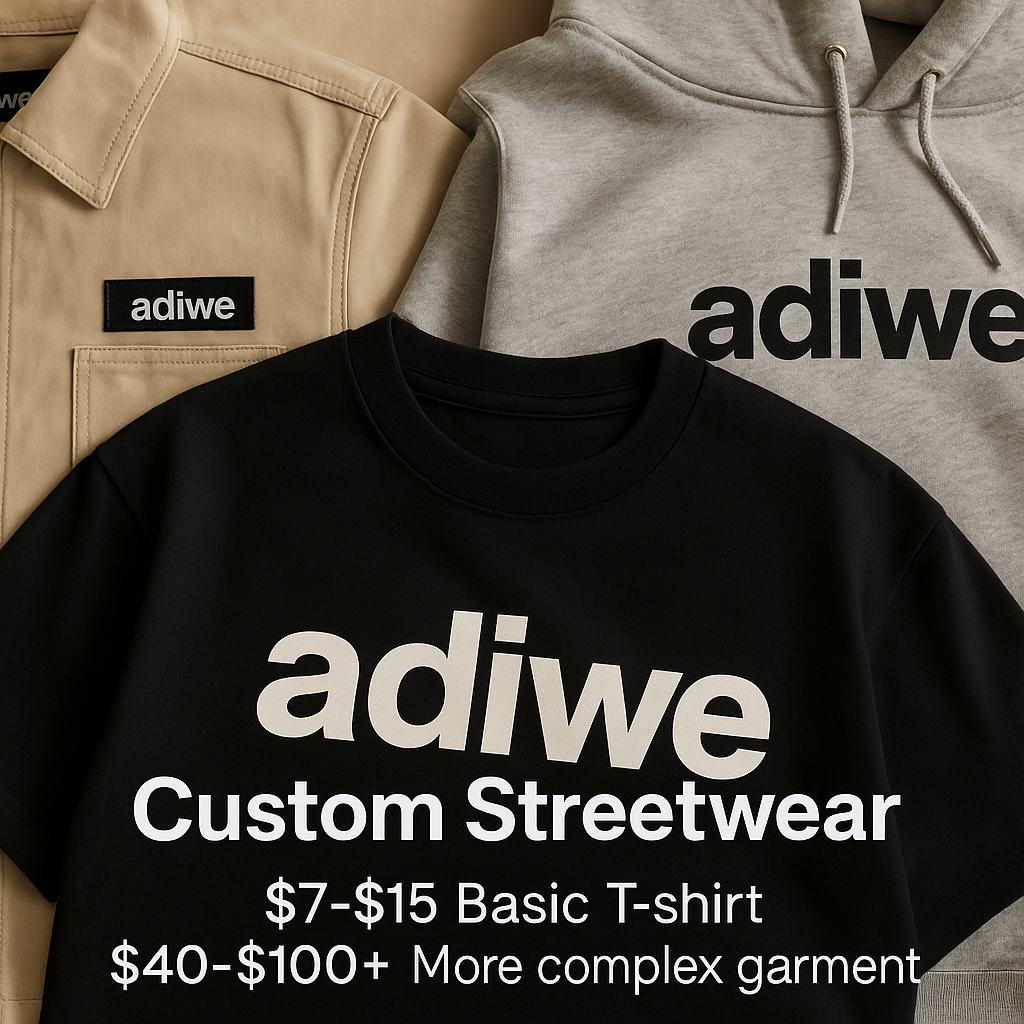
This is often the core question I discuss with clients like Fifty Fifty, who create clothing with complex styles and craftsmanship. The cost of "one piece" is not a single number; it's a sum of many parts.
-
Fabric and Material Costs
The fabric is usually the most significant component. A basic cotton jersey for a t-shirt will be much less expensive than a heavyweight organic cotton fleece for a hoodie, or a technical water-resistant fabric for a jacket. Fabric prices are usually quoted per yard or per kilogram.
-
Labor: Cut, Make, Trim (CMT)
This covers the cost of labor to cut the fabric, sew the garment, and add trims (like zippers, buttons, drawstrings). The more complex the garment's construction (e.g., number of panels, type of seams, special pocket designs), the more time it takes to make, and thus the higher the CMT cost. For intricate designs like those Fifty Fifty often requests, the CMT can be a substantial part of the cost.
-
Customizations: Prints, Embroidery, Washes
Any embellishments will add to the cost. A simple one-color screen print is cheaper than a multi-color, oversized DTG print or intricate embroidery. Special washes (like stone wash or acid wash) also add processes and therefore cost.
-
Trims, Accessories, and Finishing
Don't forget the smaller details: custom-branded zippers, unique buttons, aglets on drawstrings, eyelets, and any special finishing touches. These all contribute to the per-unit cost.
-
The Critical Role of Order Quantity (MOQ)
Minimum Order Quantity (MOQ) significantly impacts price. Setting up machinery for a small run of 50 pieces has similar fixed costs to setting up for 500 pieces. Therefore, the per-unit cost is much lower for larger orders due to economies of scale. This is why we always discuss MOQs clearly with our clients.
| Cost Component | Description | Typical Impact on Price | Example for a Hoodie (Illustrative) |
|---|---|---|---|
| Fabric | Type (e.g., 350gsm cotton fleece), consumption per piece | High | $10 - $25+ |
| CMT (Labor) | Cutting, sewing, based on complexity (e.g., paneled construction, ribbing) | High | $8 - $20+ |
| Printing/Embroidery | Type, size, colors, placement (e.g., large chest print, sleeve embroidery) | Medium to High | $3 - $15+ |
| Trims & Accessories | Zippers, drawcords, eyelets, labels, hangtags | Medium | $2 - $8+ |
| Overhead & Profit (Factory) | Factory operational costs, quality control, packaging, factory margin | Medium | Included in above, or separate % |
| Order Quantity | Smaller orders increase per-unit costs due to setup and fixed overheads | Very High | 500 units significantly cheaper than 50 units |
At Adiwe, we provide transparent, itemized quotes once we have a client's tech pack and understand their quantity needs. This way, you know exactly what you're paying for.
Conclusion
Ultimately, custom streetwear costs are a mix of your design choices, material preferences, order volume, and branding details. Careful planning and clear communication with your manufacturer will help you manage your budget effectively and build a thriving brand.

